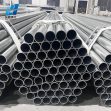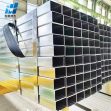Curtain wall building facades
In most cases, curtain wall facade is generally considered the first line of defense against environmental and physical exposure based on its intrinsic design in modern buildings nowadays.

In the modern times, modern curtain wall facade is regarded as an elegant component that helps to define the unique architectural aesthetics of the building. And it also has the critical role related to energy performance and interior function of a building. As technology continues to improve, different options for improvement become available for incorporation into building facades. These elements are geared toward improvement of the building envelope performance. In practical applications, curtain wall often is a combination of several system types and combined to express the architectural intent and aesthetically define the building profile. The system schemes may be an all-glazed facade (aluminum framed systems, point-supported curtain walls, cable net systems), an opaque facade (including precast, natural stone and/or metal panels) or a combination of schemes dependent on the building intent.
Curtain Wall Components
Curtain walls are generally comprised of multiple substrates including aluminum framing, stainless steel components, glazing, rubber gaskets, sealant, insulation and metal connections. The vision area allows light transmittance and the spandrel areas are designed to conceal the building floor beam structure and related mechanical elements. While the spandrel area is an opaque area, the architectural community always finds interesting ways to address the aesthetics by making the spandrel area pronounced (e.g. facade element glazing color change, material type change such as granite) or subtly blended as an all-glass facade when viewed from the exterior. In addition, aluminum curtain walls can provide significant flexibility in design profiles and are limited to the size of the die from which they are extruded or required wall thicknesses. The other important aspect is the intricacies of the system profile and the required method of attaching profiles.
Curtain Wall Installation & Maintenance
As a rule, curtain wall performance generally depends on the design and workmanship but can be enhanced by installation techniques. Traditional curtain faring may be built as a “stick system” while unitized curtain wall systems are very popular for varied reasons such as quality control, pre-assemblage of small or large units (typically floor-to-floor), field storage constraints, construction site constraints. In addition, if you want your building in good condition in the long run, it is paramount that building management conduct routine maintenance checks on the envelope enclosure, which can be incorporated in regular scheduled washing of the building where elements such as sealant, glazing and gaskets can be reviewed.
Tel: +86 18202256900 Email: steel@fwssteel.com










